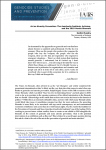The Auschwitz Institute is honored to announce the publication of “Art as Atrocity Prevention: The Auschwitz Institute, Artivism, and the 2019 Venice Biennale,” an academic article by Dr. Kaitlin Murphy in Genocide Studies and Prevention.
Dr. Kaitlin Murphy is Chair and Director of Graduate Studies in Social, Cultural, and Critical Theory and Associate Professor in the Department of Spanish and Portuguese at the University of Arizona. A long-time partner of the Auschwitz Institute, Dr. Murphy has served as an evaluator of AIPG’s Raphael Lemkin seminar and various online courses, including AIPG’s police leadership courses. She also contributed a chapter entitled “Witnessing the Past and the Present: Photography and Guatemala’s Fight for Historical Dialogue” to Historical Dialogue and the Prevention of Mass Atrocities, an edited volume organized by AIPG in cooperation with Elazar Barkan and Constantin Goschler.
“Art as Atrocity Prevention” explores the role of the arts in mitigating risk factors associated with genocide and mass atrocities, focused on the Auschwitz Institute’s 2019 Venice Biennale exhibition entitled “Artivism: The Atrocity Prevention Pavilion.” Through deep analysis and research, including fieldwork and interviews, Dr. Murphy examines the impact of the arts in society and as a powerful tool to contribute to the prevention and transformation of post-atrocity societies.
The 2019 edition of Artivism was presented alongside the 58th Venice Art Biennale and included works by artists and activist collectives from six countries: Rebin Chalak from Iraq, Canada’s National Centre for Truth and Reconciliation, Elisabeth Ida Mulyani from Indonesia, the South African Intuthuko Embroidery Project, the Argentinian Grupo de Arte Callejero (GAC), and Aida Šehović from Bosnia and Herzegovina. Dr. Murphy writes that Dr. Kerry Whigham, who represented AIPG on the exhibition’s curatorial team:
…worked to develop an exhibition that highlighted an array of distinctive ways artists and activists have used creativity to respond to large-scale identity-based violence and mass atrocity in varying conflict contexts and geographic regions across the globe.
In the article, Dr. Murphy emphasizes the ways in which different art initiatives have worked directly to mitigate atrocity risk factors and the importance of art as a method of healing and effective tool in the reconciliation process, asserting that “the process of sharing art can also be reparative.” Her research equally demonstrates the positive impact of art exhibitions like Artivism on visitors, as it encourages them to reflect on their role in mass atrocity prevention and the protection of human rights by taking action, as highlighted by Artivism’s 60/60/60 challenge. This challenge consists of choosing a human rights issue and taking three actions to be part of the solution for either 60 seconds, 60 minutes, or 60 days.
These initiatives increase public awareness and public engagement by strengthening social movements and fostering social change. Art also brings attention to ongoing human rights abuses insufficiently addressed by the national and international community. She writes:
Taken as a whole, Artivism conveyed a strikingly coherent message about the quintessential role of the arts in the prevention of systematic violence and provided an array of diverse examples of how art may be used as a grassroots tool for addressing political violence and human rights abuses—and for advancing peacebuilding, transitional justice efforts, and prevention effort.
Dr. Murphy concludes the article by stressing the importance of encouraging and supporting art programs and other spaces that enable artists and communities to exchange ideas, strengthen relationships, and build networks of accountability and support.
The exhibit asks visitors to not look away—from the art and the specific conflict contexts from which each piece originated, but most importantly from the urgency of the call for a shared commitment in prevention. Artivism brings prevention work to audiences who may have had very little prior contact with the field and asks visitors to take the work home with them. It extends the reach of the artworks displayed therein, finding for them new audiences and broader cross-cultural awareness. But Artivism does not just display powerful examples of atrocity prevention, the exhibit also actively contributes to prevention by arguing that meaningful genocide and atrocity prevention will take each and every one of us and asking for a commitment to supporting and cultivating prevention efforts all across the globe.
The Artivism exhibition is currently on display at the Canadian Museum for Human Rights (CMHR) in Winnipeg, Manitoba, Canada, where it will run until January 2022. A downloadable PDF of “Art as Atrocity Prevention: The Auschwitz Institute, Artivism, and the 2019 Venice Biennale” can be accessed as part of Volume 15, Issue 1 of Genocide Studies and Prevention, by clicking here.

